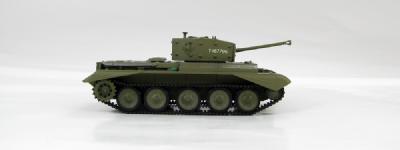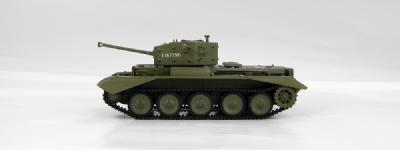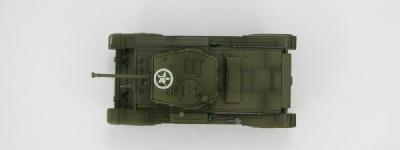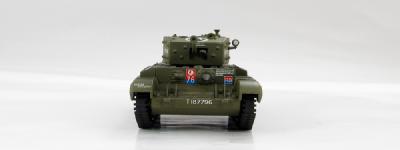Hobby Master Archive
Ground Power 1/72
Cromwell
Cromwell Mk. IV Artillery Observation tank, 5th Royal Horse Artillery, Villers-Bocage, June 1944
In WWII the British had an armour doctrine that called for two classes of tanks. Infantry tanks were just that, fairly slow well armoured with the main goal to support the infantry. The Cruiser tanks were just the opposite they compromised armour for speed and agility. This was very important during their reconnaissance roles. Using the Meteor engine the Mk. IV could attain speeds up to 52 km/h while almost gliding across the terrain on the Christie Suspension. Later models received heavier armor when it was deemed some speed should be given up for crew protection. Late in WWII there probably were more Cromwell Mk. IV in operation than any other British tank but the Churchill and the Sherman overshadowed its importance.
British General Montgomery became aware of an exposed flank of the Panzer Lehr Division. So in an attempt to circle around them and attack from the rear the British would have to take and hold the town of Villers-Bocage and the high ground Point 213. On June 13, 1944 as part of or attached to the 22nd Armoured Brigade under Brigadier W. R. N. Hinde the 5th Royal Horse Artillery was assigned to capture and hold the other exits from the city with a battery of Sextons assigned to take position to the north of D71 and in the small valley where the roads to Coudray and Chouquet Bridge run. The British were unaware of the 5 Tiger tanks and a Panzer IV led by Michael Wittmann who had seized Point 213. The British were greeted in the streets by the townsfolk who thought they had been liberated. During this greeting the British completely let down their guard and made every possible error that could be made.
Wittmann saw his chance to attack with his own Tiger I and catch the British totally by surprise. During the melee Wittmann single-handedly destroyed 10 half-tracks, 4 Carden-Loyd Carriers, 2 Bren gun-carriers, 2 anti-tank guns, 4 Cromwells, 2 Sherman Command tanks, 1 Scout Car. After being hit several times with minimum damage Wittmann’s Tiger was halted when a shell from a 6-pounder gun struck his left track. Wittmann and crew escaped on foot and joined up with reinforcements and attacked the town again. There was heavy fighting because the element of surprise had been lost but in spite of having reinforcements available not one British commander called for them. As a result the British were forced to retreat and several officers were relieved of command.
One commanding officer of the British Forces that were never called upon described things this way; the whole thing was a disgrace. Because of poor execution of a plan a great opportunity to drive the Germans from this area of France was lost. A second attempt by the British to take Villers-Bocage also failed and this only added to the great propaganda opportunities for the Germans who raised Wittmann to hero status and he became a legend. Wittmann is credited with 27 out of the 30 or so vehicles destroyed during this confrontation.
The British started with 200 armored vehicles and their losses were: 5th Royal Horse Artillery 2 Cromwells, 1 Sherman. 8th King’s Royal Irish Hussars numerous Shermans. 4th County of London Yeomanry 8 Cromwells, 4 Sherman Fireflies, 3 Stuarts, 1 half- track, 3 Scout cars. Rifle Brigade 9 half-tracks, 2 Bren gun-carriers, 4 Carden-Loyd Carriers.
Throughout the battle the Germans had 25 tanks and their losses were: 6 Tiger Is of which 3 were repaired. 5 Panzer IVs.
| Added to archive | 2015-11-19 |
| Last modified | 2015-11-19 |
| Leaflet | 2007-12-01 December 2007 |






